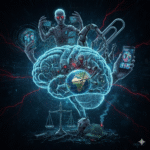For the past decade, headlines have fixated on the volatile drama of public cryptocurrencies. While the world watched the speculative rise and fall of various tokens, a quieter, more profound revolution has been taking place. Far from the public exchanges, the world’s largest and most conservative financial institutions have moved past skepticism and are now deep into the execution phase of adopting blockchain and distributed ledger technology (DLT).
This isn’t an experiment anymore. Major banks are actively building and deploying DLT solutions to solve some of the oldest and most expensive problems in finance. They are not simply “buying crypto”; they are re-engineering the fundamental plumbing of the global financial system. From cross-border payments to the very nature of what an “asset” is, the changes happening behind the scenes are staggering—and they are accelerating.
1. The 24/7 Payments Revolution: From Wires to Instant Settlement
The most immediate and impactful area of adoption is in payments and settlements. The current financial system, largely reliant on networks like SWIFT and correspondent banking, is a relic. It’s slow, expensive, and famously only operates during “business hours.” For a global, 24/7 economy, this friction costs trillions.
J.P. Morgan’s Public Leap: J.P. Morgan has been the undisputed leader in this space. Their private, permissioned blockchain network, Onyx (now part of Kinexys), has been a workhorse, processing billions of dollars in daily transactions using its “JPM Coin”—a digital token representing U.S. dollar deposits.
But the most significant development just happened. J.P. Morgan has taken its JPM Coin (JPMD) off its private network and launched it on a public, albeit permissioned, Layer 2 blockchain: Base. This is a monumental step. It signals a move from a closed-loop “walled garden” to an interoperable ecosystem. Institutional clients like B2C2, Coinbase, and Mastercard can now use a fully regulated, bank-backed deposit token to settle transactions on a public blockchain, 24/7, in near real-time. This bridges the gap between traditional finance and the decentralized Web3 economy.
Citi’s Network of Networks: Citibank is tackling the same problem with a different, powerful approach. Their “Citi Token Services” platform is being integrated directly with their “24/7 USD Clearing” solution. This industry-first move creates a network that allows for instant, cross-border payments not just between Citi accounts, but also to and from non-Citi accounts. By combining the immutability of blockchain with its existing global clearing network, Citi is building a high-speed rail for institutional money that operates around the clock.
2. Asset Tokenization: The $10 Trillion+ Prize
Perhaps the most transformative use case is asset tokenization. This is the process of converting real-world assets (RWAs)—like stocks, bonds, real estate, or even fine art—into digital tokens on a blockchain.
Why do this? It unlocks unprecedented liquidity, enables fractional ownership, automates compliance via smart contracts, and allows for “atomic settlement,” where the asset and the payment are exchanged simultaneously, eliminating counterparty risk.
Goldman Sachs and UBS Go Live: Goldman Sachs’ Digital Asset Platform (GS DAP™) isn’t a whitepaper; it’s a live, end-to-end platform. It’s being actively used to issue and manage digital assets. The European Investment Bank (EIB), for example, has used blockchain platforms to issue multiple digital bonds, including a €100 million bond settled in central bank digital money on the Banque de France’s DLT.
Similarly, Swiss giant UBS has successfully tokenized a money market fund (named “uMINT”) on the public Ethereum blockchain, using Chainlink’s protocols to connect on-chain data with the real world. This live test proves that highly regulated, traditional assets can be securely managed on public networks. UBS is also partnering with Ant International (Alipay+) to use “UBS Digital Cash,” its tokenized deposit, for instant multi-currency payments within Ant’s treasury, streamlining operations for one of the world’s largest fintech firms.
3. Building the Scaffolding for a New Economy
Banks aren’t just using blockchain; they are building the essential, regulated infrastructure that will allow the new digital economy to merge with the old.
BNY Mellon, The Custodian: As the world’s largest custodian bank, BNY Mellon understands infrastructure. They see blockchain as the future of “immutable recordkeeping.” Their most recent move is a perfect example: the launch of the “BNY Dreyfus Stablecoin Reserves Fund.” This is a money market fund specifically designed to hold the reserves for regulated stablecoin issuers. In short, BNY Mellon is building the regulated, transparent, and trusted vault that will back the digital dollars of the future.
Digital Identity and Trade Finance: Beyond payments and assets, DLT is solving other chronic headaches. The $2.5 trillion global trade finance gap exists because the industry is drowning in paper (bills of lading, letters of credit), making it slow and prone to fraud. Blockchain provides a single, unchangeable digital record that all parties—importer, exporter, banks, and shippers—can trust and track in real time.
This same principle applies to digital identity. Banks spend billions on redundant “Know Your Customer” (KYC) checks. The EU is now mandating a “European Digital Identity Wallet” (EUDIW) by 2027, and banks are already piloting this. The goal is a single, secure, verifiable digital ID that, once approved, can be used across all banks and services, slashing costs and improving user experience.
Conclusion: The Quiet Re-Platforming of Finance
The road ahead still has challenges, primarily revolving around regulatory clarity and interoperability—getting all these different bank blockchains to talk to each other. But the “how” is becoming clearer. It’s a hybrid world of private blockchains (like Hyperledger and Corda), public blockchains (like Ethereum), and critical “oracle” services (like Chainlink) that securely feed real-world data to the smart contracts.
What is certain is that the shift is irreversible. While public attention is on the next crypto bull run, the titans of finance are quietly placing their bets not on speculative tokens, but on the underlying technology. They are rebuilding the back office of the global economy. This “behind the scenes” adoption is less dramatic, but its impact will be infinitely more profound. The very definition of banking, assets, and money is being re-written, one block at a time.

